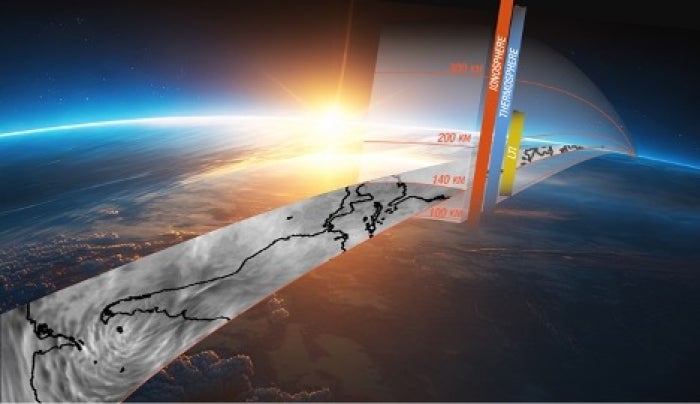ASU scientist part of NASA DYNAMIC mission proposal team to study space weather

Aurora and airglow are seen from the International Space Station in 2015. Photo credits: NASA/JSC/ESRS
A joint proposal from a team of institutions including Arizona State University has been selected for concept studies for NASA’s Dynamical Neutral Atmosphere-Ionosphere Coupling (DYNAMIC) mission.
The proposal is led by the University of Colorado, Boulder, in collaboration with ASU, Johns Hopkins Applied Physics Laboratory, NASA’s Jet Propulsion Laboratory, Clemson University, University of Alaska Fairbanks, the National Center for Atmospheric Research and the Massachusetts Institute of Technology’s Haystack Observatory.
The proposal was submitted by Principal Investigator Tomoko Matsuo of the University of Colorado, Boulder, and includes Co-Investigator Katrina Bossert, an assistant professor jointly in ASU’s School of Earth and Space Exploration and School of Mathematical and Statistical Sciences. The team is one of three winning teams selected to receive funding for a Phase-A, nine-month concept study, after which NASA will select a single winning proposal.
“This is an amazing opportunity to work with a talented group of scientists and engineers,” Bossert said. “The proposed mission instrumentation would provide measurements that allow for the study of interconnections between forcing from Earth’s atmosphere and the sun at altitudes that overlap with the satellite low Earth orbit region.”
When launched, DYNAMIC is expected to provide comprehensive measurements of the upper atmosphere in the very low Earth orbit (VLEO, below 300 km) range — the new frontier for spacecraft operation. This will provide a deeper understanding into how space weather — events generated by activity on the sun and the Earth’s weather — can interfere with satellites, navigation systems and other technology.
“We’re grateful and overjoyed for this opportunity to work together to make our vision of DYNAMIC a reality. With these measurements, we can finally gain an understanding of the critical link between Earth’s atmosphere and space,” said Matsuo, an associate professor in the Ann and H. J. Smead Department of Aerospace Engineering Sciences at the University of Colorado, Boulder.
“Earth and space are an interconnected system that reaches from the heart of our solar system, the sun, to the lowest reaches of the atmosphere where we live, and extends to the edge of our heliosphere — the boundary of interstellar space,” said Nicola Fox, associate administrator, Science Mission Directorate at NASA Headquarters in Washington, D.C.
“While space weather can spark the beautiful auroras across our skies, it also has the potential to cause disruptions for us here on Earth and can be dangerous for our spacecraft and astronauts in space. The DYNAMIC mission will expand our understanding of how Earth itself shapes space weather events that influence our home planet.”
Adapted from NASA, APL, CU Boulder release with contributions from ASU.
More Science and technology

Transforming Arizona’s highways for a smoother drive
Imagine you’re driving down a smooth stretch of road. Your tires have firm traction. There are no potholes you need to swerve to avoid. Your suspension feels responsive. You’re relaxed and focused on…

The Sun Devil who revolutionized kitty litter
If you have a cat, there’s a good chance you’re benefiting from the work of an Arizona State University alumna. In honor of Women's History Month, we're sharing her story.A pioneering chemist…

ASU to host 2 new 51 Pegasi b Fellows, cementing leadership in exoplanet research
Arizona State University continues its rapid rise in planetary astronomy, welcoming two new 51 Pegasi b Fellows to its exoplanet research team in fall 2025. The Heising-Simons Foundation awarded the…


